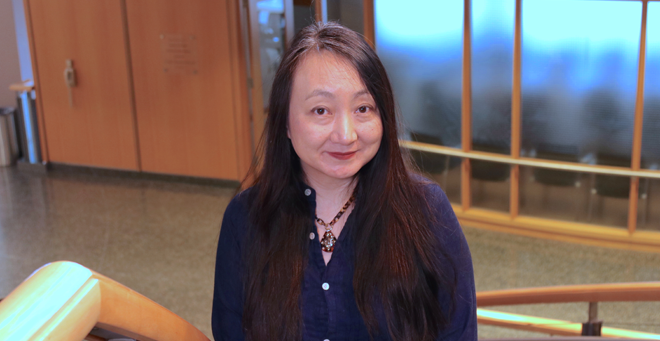
The worst influenza season in years is affecting millions of people across the country, according to the Centers for Disease Control, landing many in hospitals and resulting in death for some. A team of researchers at UMass Medical School is focused on how to better treat the flu.
In this Expert’s Corner Q&A, infectious disease specialist, immunologist and hospital physician Jennifer Wang, MD, discusses the scientific underpinnings of a severe flu season, and the innovative research she and colleagues at UMass Medical School, the Dana-Farber Cancer Institute and Arizona State University are conducting to find better means of treatment and prevention.
Dr. Wang, associate professor of medicine in the Division of Infectious Diseases and Immunology, is an investigator on a grant from the Department of Defense Peer Reviewed Medical Research Program to develop new technologies and strategies to treat the flu. Robert Finberg, MD, the Richard M. Haidack Professor of Medicine and chair and professor of medicine, is principal investigator for “Anticipating Influenza Resistance Evolution: Pathways and Strategies.” UMMS researchers involved in the $10 million, 5-year grant include Celia Schiffer, PhD, professor of biochemistry & molecular pharmacology and director of the Institute for Drug Resistance; Timothy Kowalik, PhD, professor of microbiology & physiological systems; Daniel Bolon, PhD, professor of biochemistry & molecular pharmacology; Daniel Caffrey, PhD, assistant professor of medicine; and Manuel Garber, PhD, associate professor of molecular medicine.
Why has the United States been hit so hard by flu this year?
Flu happens every single year, with seasonal variations. This year happens to be one that is more severe. While people likeliest to be hardest hit are the elderly, very young children and those with compromised immune systems, anyone can be susceptible to flu. Healthy people do die every year and we don’t know if there’s anything inherently more virulent about the circulating strains of flu, but with more cases overall, the numbers of deaths are also up, including more elderly and children who are being hospitalized as well as healthy kids and adults. We don’t yet fully understand why individual immune responses vary, why some get sick and some don’t, and some get sicker than others do. That is in part what our research is about.
How effective is this season’s flu vaccine?
The vaccine is formulated in advance, based on predictions to make it is as protective as possible. It is never perfect but it is always partially effective, and some protection is always better than none. Preliminary numbers indicate that this year’s vaccine is at least somewhat effective.
Why should people be vaccinated late in the season?
Vaccination, even late in the season, protects the individual for the remainder of the season, and protects others from getting sick with so-called herd immunity. While the season may be at its peak now, we are only halfway through, with weeks to go.
Is it true that the antiviral medicine Tamiflu can prevent as well as treat the flu, and if so, how does it work?
There are data showing that Tamiflu can be preventive for somebody who has had direct contact with an infected person. For example, in a household with a sick child, another family member at high risk may be offered a prescription, which will slightly reduce their chances of getting sick. However, Tamiflu is more frequently used for treatment, and is prescribed for prevention only on a case-by-case basis.
How does the influenza virus evolve?
The virus naturally evolves by single point mutations known as drift, which occurs as the virus migrates through the population. The current year’s most prevalent flu strain is likely to have mutated from the prior year’s. New vaccines are designed each year because drift occurs every year.
This season, H1N1 and Influenza B strains are circulating as well as the predominant H3N2. Both influenza A strains, H1N1 and H3N2 differ in hemagglutinin (the ‘H’) and neuraminidase (the ‘N’), the two glycoproteins in the virus that initiate infection. They are what we study in the lab.
What is your research on flu treatment and prevention, and where does it stand?
We have learned about how the virus mutates, and we are working on several promising drug candidates. We are studying monoclonal broadly neutralizing antibodies that could work for somebody infected with either H3N2 or H1N1 flu. Our own MassBiologics already manufactures monoclonal antibodies for a number of other infectious diseases.
We are also looking at antivirals other than Tamiflu, like cap snatching inhibitors, which block replication of the virus differently than Tamiflu.
We have been working with laboratory-approved human flu strains, conducting high throughput sequencing to test drug candidates.
What’s next?
New this year, we are starting to look directly at clinical samples from individual patients. This is very interesting and exciting because we can do deep sequencing at the individual patient’s single cell level to learn more about individual host cell responses. This will help us identify new targets for alternative therapies.
While our focus is on treatment, we may eventually apply some of these new technologies to expanded studies of blood cell response pre- and post-vaccine to better understand the host response to vaccine.
Why is this work important?
Whether mild or severe, the annual flu season will occur every winter. Even though some people underestimate the flu, we know it has potential to fill up our hospitals and cause deaths in people every year. With so many affected, it is important to improve prevention and treatment of influenza until we can eradicate it.
Related stories on UMassMedNow:
UMMS study examines association between common childhood infection and type 1 diabetes
Predicting flu: UMass Medical School team developing tools for anticipating viral evolution
UMMS expert seeks better flu vaccines